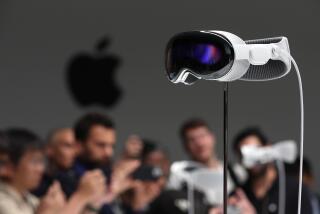Book review: ‘Infinite Reality’ by Jim Blascovich and Jeremy Bailenson
Humanity may be in the process of being transformed by a virtual revolution, but as Jim Blascovich and Jeremy Bailenson tell it in their exhilarating book “Infinite Reality,” virtual worlds are as old as human experience, whether one is thinking of the cave paintings in Lascaux, France, the Ayahuasca trips of the Amazonian Urarina people or Orson Welles’ 1938 radio broadcast of “The War of the Worlds.” To a large extent, then, the virtual revolution underway is not merely a technological sleight of hand in which digital immersive tools trick the mind into accepting artificial environments as real, but something more profound — the fulfillment of an ancient human impulse. It turns out we have always been, to borrow a phrase, “here to go,” from the “grounded” physical world to the virtual.
That realization does not make the virtual revolution any less startling nor its potential to alter humanity any less profound. The authors make a compelling case that advances in digital media, such as HD television, have cracked open the gate and the technology has the potential to “blast the gates off their hinges.” The world had a taste of it with James Cameron’s movie “Avatar.” But the virtual experience isn’t something confined to 3-D films or the next generation Wii and or PlayStation systems. Blascovich and Bailenson argue that the virtual revolution is recasting the grounded world. We are living a Gutenberg moment.
“Infinite Reality” is an apt title, and the potential is mind-boggling, especially when it comes to the matter of avatars, digital representations driven by the actions of real people, usually in real time. Psychological experiments are finding that people actually change after “wearing” avatars: They become more confident because their avatars, or digital selves, are taller, or slimmer, or younger, or more attractive, or able-bodied. It is not just simple role-playing: People are actually evolving, in a sense becoming somewhat different people.
Isolated people, for example, need no longer be lonely, as they can use their avatar to enjoy the social stimulation missing from their real existences. Avatars can help people discover aspects of themselves they never knew existed. People might develop greater empathy for, say, the opposite sex, for in the virtual world girls can be boys and boys can be girls. And for those who would argue that virtual relationships are inherently empty because they lack physical expression, there is the potential of sexual stimulation devices that can be manipulated by others online (remember the Orgasmatron from Woody Allen’s movie “Sleeper”?).
And then there are the commercial applications. Already virtual technology is being used to sell books. When I was promoting one of my own, I — or at least my avatar — appeared on Meet an Author with Adele Ward on Second Life’s treet.tv. The audience was made up of avatars, behind whom were real people, taking in the discussion about what is called “the third man phenomenon,” an experience in which people in extreme duress encounter an unseen presence, or angel, that helps them to survive. The irony of using an avatar to promote a book on this subject did not escape me. Doubtless Blascovich and Bailenson will soon be unleashing armies of avatars to do the heavy lifting for their book promotion.
At times, “Infinite Reality” is almost giddy at the prospects of how the virtual revolution will change, and often improve, our world. They describe how, in their lab, people who watch their virtual doppelgängers shed virtual pounds are actually inspired to exercise harder. But the authors are also conscious of the potential for abuse as well. They show how virtual doppelgängers can create false memories, how “virtual behaviour is controlled by computer programmers and animators,” and they raise the specter of addicted users who “withdraw physically from society.” Real society, that is.
But then, they ask, what is real? Perception, they point out, is based on constructed information and is still experienced subjectively: “If all of perceived reality is virtual,” they explain, “then the notion that ‘true’ experience can only be had in physical reality seems, well, unreal.” If you accept that premise, then the possibilities truly are endless. If the essence of a person, not only their appearance but vital aspects of their personality and character, can be captured digitally, then the elixir of life is at hand. Buzz Lightyear put it best: “To infinity … and beyond!”
Blascovich and Bailenson are ideally situated to write this guide to the new world coming; they are scholars in the field who communicate complex ideas to readers without seeking refuge in techno jargon. It’s a rare skill that makes “Infinite Reality” a must-read for anyone who wants to prepare for the coming revolution.
Geiger is author of “The Third Man Factor: Surviving the Impossible.” A documentary, “The Angel Effect,” which is based on the book, recently aired on National Geographic Channel.
More to Read
The biggest entertainment stories
Get our big stories about Hollywood, film, television, music, arts, culture and more right in your inbox as soon as they publish.
You may occasionally receive promotional content from the Los Angeles Times.










